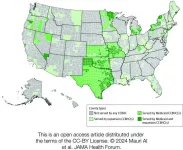(Press-News.org) A decade after the establishment of the certified community behavioral health clinic (CCBHC) model, more than 60 percent of the US population has access to such facilities and the mental health and substance use disorder treatment services they provide, according to a new study led by researchers at the NYU School of Global Public Health. Moreover, these clinics are expanding the availability of crisis mental health services, including mobile crisis response teams and stabilization.
“Certified community behavioral health clinics have become a cornerstone of bipartisan strategies to increase access to and improve the quality of behavioral health care in the United States,” said Amanda Mauri, an assistant professor/faculty fellow at the NYU School of Global Public Health and the lead author of two new studies on CCBHCs.
A new approach to community-based behavioral health care
CCBHCs fulfill federal criteria related to providing outpatient mental health and substance use care, including crisis services, regardless of patients’ ability to pay. The federal government established the criteria for the CCBHC model in 2014, and the first CCBHCs opened in October 2016. Clinics that become CCBHCs are typically community mental health centers that offered outpatient behavioral health care before becoming CCBHCs, but other types of facilities—like hospitals and federally qualified health centers—are also receiving CCBHC designation.
“The creation of CCBHCs marks the first significant shift in federal involvement in community behavioral health care since the 1980s, when Congress converted the national community mental health center program to a block grant,” said Mauri. “Given this important policy change, it is essential to evaluate whether and in what ways CCBHCs change community behavioral health care, particularly for persons who are uninsured, underinsured, and enrolled in Medicaid.”
Over the past decade, federal funding for CCBHCs has increased—for instance, the Bipartisan Safer Communities Act, which became law in 2022, funnels $8.5 billion over 10 years into CCBHCs. Clinics can become designated as CCBHCs through two initiatives: Medicaid programs that make bundled payments to clinics on a daily or monthly basis, or through the Substance Abuse and Mental Health Services Administration (SAMHSA) Expansion Grant program.
Despite the significant investment in CCBHCs, there is little research on these clinics: where they are located, what services they provide, and who they reach. To address this gap, Mauri and her colleagues created a dataset of CCBHCs and began exploring their reach and services.
The wide reach of CCBHCs
In a study published Oct. 4 in JAMA Health Forum, the researchers found that CCBHCs have a wide-reaching network, with the proportion of US counties and people residing within a CCBHC service area substantially growing since the first clinics opened in 2016.
As of June 2024, 39.43 percent of counties are served by CCBHCs (22.85 percent of counties served by Medicaid CCBHCs and 25.37 percent of counties served by SAMHSA-funded Expansion CCBHCs, with some served by both). More than half of CCBHCs serve multiple counties. In addition, the majority of the US population—62.26 percent—have access to mental health care through local CCBHCs (26.63 percent by Medicaid CCBHCs and 53.93 percent by Expansion CCBHCs, with some served by both).
While the researchers found geographic differences in where CCBHCs are located, they note that these disparities do not necessarily fall along partisan lines. For instance, Texas was an early adopter of CCBHCs, establishing statewide access through a Medicaid program. In contrast, North Dakota, South Dakota, Delaware, and South Carolina had no CCBHCs as of June.
“This is one of the few policy spaces where there's bipartisan support—we're seeing Republican and Democratically controlled states alike launching CCBHC initiatives, and we’ve seen significant investments in the program under the Obama, Trump, and Biden administrations,” said Mauri.
Increasing crisis services
CCBHCs are required to provide the three main types of behavioral health crisis care: 24/7 call lines, mobile crisis response, and crisis stabilization. The need for crisis services has grown since the 2022 launch of 988, the new national number for the Suicide and Crisis Lifeline.
To better understand the crisis services provided, Mauri and her colleagues analyzed national survey data from the National Council for Mental Wellbeing on CCBHCs, along with the demographics and socioeconomics of the areas they serve. Their findings were published last month in the journal Psychiatric Services.
The research found that clinics receiving CCBHC Medicaid bundled payments had much higher odds of adding new crisis services when becoming CCBHCs than clinics not receiving these Medicaid payments.
“This suggests that the CCBHC Medicaid bundled payments matter and may be effective tools for increasing the availability of resource-intensive crisis care, like mobile crisis response and crisis stabilization services,” said Mauri.
The researchers also found that CCBHCs with higher staffing levels relative to the population they serve were more likely to directly provide crisis services, rather than contracting with third-party providers.
In addition to Mauri, study authors for the JAMA Health Forum study include Nuannuan Xiang of Columbia University Mailman School of Public Health, Danielle Adams of the University of Missouri-Columbia, and Jonathan Purtle of the NYU School of Global Public Health; additional study authors for the Psychiatric Services article include Saba Rouhani and Jonathan Purtle of the NYU School of Global Public Health. The research was funded in part by the National Institute of Mental Health (R01 MH121649).
END
Studies examine growing US mental health safety net
Reach of certified community behavioral health clinics reflects bipartisan support for investment in improving behavioral health
2024-10-04
ELSE PRESS RELEASES FROM THIS DATE:
Social risk factor domains and preventive care services in US adults
2024-10-04
About The Study: This cross-sectional study of U.S. adults suggests that social risk factor domains were associated with decreased odds of receiving preventive services; this association was cumulative. There is a need to address social risk factors to optimize receipt of recommended preventive services.
Corresponding Author: To contact the corresponding author, Leonard E. Egede, MD, MS, email legede@buffalo.edu.
To access the embargoed study: Visit our For The Media website at ...
Online medication abortion direct-to-patient fulfillment before and after the Dobbs v Jackson decision
2024-10-04
About The Study: The findings of this study suggest that online pharmacies play an increasingly critical role in direct-to-patient medication abortion provision, especially with virtual-only platforms. These findings suggest that barriers to accessing online pharmacies for abortion care should be removed.
Corresponding Author: To contact the corresponding author, Caila Brander, MSc, email cbrander@ibisreproductivehealth.org.
To access the embargoed study: Visit our For The Media website at this link https://media.jamanetwork.com/
(doi:10.1001/jamanetworkopen.2024.34675)
Editor’s ...
Black, Hispanic, and American Indian adolescents likelier than white adolescents to be tested for drugs, alcohol at pediatric trauma centers
2024-10-04
Injured adolescents from marginalized groups treated at pediatric trauma centers are more likely to be tested for drugs and alcohol than white adolescents, even when accounting for injury severity, a study led by researchers at UCLA and Children’s Hospital Los Angeles suggests.
The findings, to be published October 4 in the peer-reviewed JAMA Network Open, suggest that clinician biases could influence the selection of adolescents for biochemical substance use screening at pediatric trauma centers, said Dr. Jordan Rook, a general surgery resident at the David Geffen School of Medicine at UCLA and the study’s lead author. ...
Pterosaurs needed feet on the ground to become giants
2024-10-04
The evolutionary adaptations that allowed ancient pterosaurs to grow to enormous sizes have been pinpointed for the first time by palaeontologists in the Centre for Palaeobiology and Biosphere Evolution at the University of Leicester.
The discovery revealed a surprising twist – the ability to walk efficiently on the ground played a crucial role in determining how large the biggest flying animals could grow, with some reaching wingspans of up to 10 metres.
In a new study published today (4 October) in Current ...
Scientists uncover auditory “sixth sense” in geckos
2024-10-04
University of Maryland biologists identified a hidden sensory talent in geckos that’s shaking up what we thought we knew about animal hearing.
In a new study published in Current Biology on October 4, 2024, the researchers revealed that geckos use the saccule—a part of their inner ear traditionally associated with maintaining balance and body positioning—to detect low-frequency vibrations. According to the researchers, this special “sixth sense” also plays a complementary role to the geckos’ normal hearing and the way they sense ...
Almost half of persons who inject drugs (PWID) with endocarditis will die within five years; women are disproportionately affected
2024-10-04
LONDON, Ont. and REGINA, Sask. – People who inject drugs are dying at an alarming rate from endocarditis, a serious but treatable heart-valve infection.
But their odds of survival improve dramatically, even five years after their first admission to hospital, if they’re treated not just for heart infection but are also provided with addiction support while in hospital, a Canadian study shows.
The study also highlights that women who inject drugs are particularly vulnerable to endocarditis and are affected in disproportionately high numbers.
“Endocarditis is potentially lethal and always costly,” says Dr. Michael Silverman, an infectious ...
Experimental blood test improves early detection of pancreatic cancer
2024-10-04
GRAND RAPIDS, Mich. (Sept. 30, 2024) — An experimental blood test detects early-stage pancreatic cancer more effectively than other available tests, reports a new study published in Cancer Letters.
The findings pave the way for further evaluation of the test in a clinical setting, an important step toward approval as a potential diagnostic method for pancreatic cancer.
“Catching pancreatic cancer early dramatically improves survival, but our current tools for doing so are limited,” said the study’s co-corresponding author Brian Haab, Ph.D., a professor at Van Andel Institute. “Our results reveal that our combination ...
Groundbreaking wastewater treatment research led by Oxford Brookes targets global challenge of toxic ‘forever chemicals’
2024-10-04
Researchers at Oxford Brookes University have pioneered a groundbreaking method to tackle one of the world’s most persistent environmental threats—toxic chemicals in global water supplies.
They have developed a new machine called a hydrodynamic reactor that uses bubbles which form and collapse due to changes in pressure, a process called cavitation. The reactor removes toxic per- and poly-fluoroalkyl substances (PFAS), also known as “forever chemicals” from water.
PFAS chemicals were invented in the 1930s and used in convenience products ...
Jefferson Health awarded $2.4 million in PCORI funding
2024-10-04
PHILADELPHIA, Oct. 3, 2024 — Jefferson Health has been awarded $2.4 million by the Patient-Centered Outcomes Research Institute (PCORI) to implement evidence-based patient education and coaching programs for weight loss across Jefferson Primary Care.
U.S. adult obesity rates have risen to over 40% in the past two decades, increasing risks of diabetes, heart disease and premature death. Led by Baligh Yehia, M.D., MPP, MSHP, President of Jefferson Health, this project will implement sustainable health education programs ...
Cilta-cel found highly effective in first real-world study
2024-10-04
(WASHINGTON – October 4, 2024) In the first study to report real-world outcomes from ciltacabtagene autoleucel (cilta-cel), a chimeric antigen receptor (CAR)-T therapy for multiple myeloma, patients experienced efficacy and safety results similar to those seen in clinical trials, according to results published today in Blood.
Of 236 patients who received cilta-cel infusions at 16 U.S. medical centers in 2022, 89% saw their cancer respond to the treatment and 70% had a complete response, meaning there was no detectable cancer after the treatment. These numbers ...
LAST 30 PRESS RELEASES:
Heart-brain connection: international study reveals the role of the vagus nerve in keeping the heart young
Researchers identify Rb1 as a predictive biomarker for a new therapeutic strategy in some breast cancers
Survey reveals ethical gaps slowing AI adoption in pediatric surgery
Stimulant ADHD medications work differently than thought
AI overestimates how smart people are, according to HSE economists
HSE researchers create genome-wide map of quadruplexes
Scientists boost cell "powerhouses" to burn more calories
Automatic label checking: The missing step in making reliable medical AI
Low daily alcohol intake linked to 50% heightened mouth cancer risk in India
American Meteorological Society announces Rick Spinrad as 2026 President-Elect
Biomass-based carbon capture spotlighted in newly released global climate webinar recording
Illuminating invisible nano pollutants: advanced bioimaging tracks the full journey of emerging nanoscale contaminants in living systems
How does age affect recovery from spinal cord injury?
Novel AI tool offers prognosis for patients with head and neck cancer
Fathers’ microplastic exposure tied to their children’s metabolic problems
Research validates laboratory model for studying high-grade serous ovarian cancer
SIR 2026 delivers transformative breakthroughs in minimally invasive medicine to improve patient care
Stem Cell Reports most downloaded papers of 2025 highlight the breadth and impact of stem cell research
Oxford-led study estimates NHS spends around 3% of its primary and secondary care budget on the health impacts of heat and cold in England
A researcher’s long quest leads to a smart composite breakthrough
Urban wild bees act as “microbial sensors” of city health.
New study finds where you live affects recovery after a hip fracture
Forecasting the impact of fully automated vehicle adoption on US road traffic injuries
Alcohol-related hospitalizations from 2016 to 2022
Semaglutide and hospitalizations in patients with obesity and established cardiovascular disease
Researchers ‘listen in’ to embryo-mother interactions during implantation using a culture system replicating the womb lining
How changing your diet could help save the world
How to make AI truly scalable and reliable for real-time traffic assignment?
Beyond fragmented markets: A new framework for efficient and stable ride-pooling
Can shape priors make road perception more reliable for autonomous driving?
[Press-News.org] Studies examine growing US mental health safety netReach of certified community behavioral health clinics reflects bipartisan support for investment in improving behavioral health





